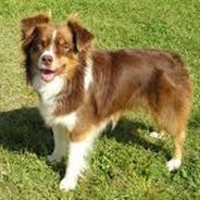Appearance of the Australian Eskimo
|
| The Australian Eskimo is a fairly large dog, with males weighing up to 27 kilos and standing up to 48 centimeters tall. Their coats are quite hard and generally wavy, and they often have a variety of markings that may be speckled. Your pet is likely to adopt many of the characteristics of the parent breeds. Australian Shepherds have bright, expressive, almond-shaped eyes that are either brown or amber, although some may have blue eyes. Their ears are medium-sized, triangular and slightly rounded at the tips. They have strong white teeth and a muzzle that tapers slightly towards the rounded tip. Their paws are oval-shaped and the tail is straight or can be docked. The medium-length coat is available in blue or red merle, red tricolor or black, all with white and/or tan markings. American Eskimo Dogs have a straight, fluffy white double coat, slightly oval black eyes and erect triangular ears. They often have tear spots under their eyes, which are medium to dark brown. American Eskimo Dogs are known for their alert, lively and brilliant expression. The muzzle is broad and the jaw strong with well-fitting teeth. Their paws are oval and their tails run up their backs. |
Temperament of the Australian Eskimo
|
| Australian Eskimos are intelligent, loyal dogs. They are full of energy, very playful and known to be affectionate towards their owners. They are not considered the best watchdogs, as they don't necessarily bark at strangers. Because of their Australian Shepherd ancestry, they have a herding instinct, but are more fun and good pets. As with any new dog entering a family, it will be a good idea to take them into training to help them develop good socialization skills with other animals. Australian Eskimos are considered moderate when it comes to training, but if owners persevere, they will be rewarded. As the Australian Eskimo is a combination of an Australian Shepherd and an American Eskimo Dog, their temperament will be quite similar. Australian Shepherds thrive on human companionship and love to please, while American Eskimo Dogs are good with other dogs, cats and new owners. They are also very good with children. |
Needs and activities of the Australian Eskimo
|
| Your Australian Eskimo will need plenty of exercise and playtime to keep fit and happy in all weathers and climates. They are full of energy and are very playful dogs, so daily walks are a must. They would do best in a house with a fenced yard, but could be kept in an apartment provided they are taken out daily for exercise. Children can keep your dog busy. Both parent breeds need plenty of exercise, with the American Eskimo Dog needing sufficient activity to prevent boredom from setting in and the potential for destructive behavior. The Australian Shepherd's love games, such as Frisbee or fetch, also benefit from mental stimulation. |
Maintenance of the Australian Eskimo
|
| Australian Eskimos are fairly easy to care for, but require regular brushing to maintain their appearance. Try to brush them at least twice a week. It's a good idea to trim the fur in summer, and make sure the dog's tick and flea medication is up to date so he doesn't scratch himself, as he's prone to allergies. None of its parent breeds is hypoallergenic, nor is the Australian Eskimo. All dogs need good dental care, so it's important to brush their teeth every day from an early age so that it becomes a habit. Regular ear cleaning and nail trimming should be an integral part of your Australian Eskimo's maintenance. |









 English (United Kingdom)
English (United Kingdom)